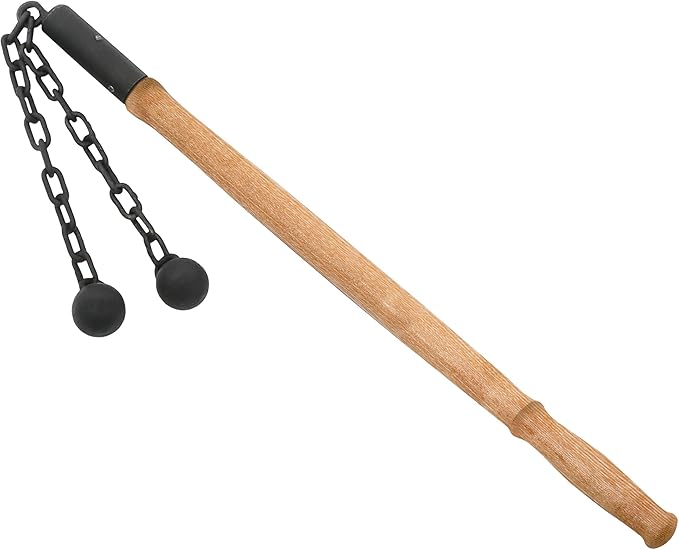~ The Flail
Medieval Weaponry ~
The Flail in the Medieval Era
Of all the weapons of the medieval battlefield, few are as visually distinctive and controversial as the flail. With its swinging, chain-connected head, the flail evokes images of chaos and destruction. But how real was it? Was it used effectively in combat, or was it more a creation of imagination and later art? The truth, like many things in history, lies somewhere in between.
What Is a Flail?
The flail is a blunt weapon consisting of a handle (or haft) attached by a chain or rope to one or more striking heads. These heads were typically made of wood, iron, or steel, and sometimes spiked. The flail is technically a type of mace — with the key difference being the flexible joint between handle and head, which gives it a unique swinging motion.
Basic Parts of a Flail
- Handle: A wooden or metal shaft held by the user, usually 1 to 2 feet in length
- Chain or hinge: Connects the striking head to the handle, allowing it to swing freely
- Striking head: Often a metal ball, with or without spikes, designed to crush armor and flesh
Origins of the Flail
The flail likely evolved from agricultural tools used for threshing grain. Peasant levies or militias may have adapted these tools for self-defense, especially during uprisings or local skirmishes. Over time, the concept was militarized into a weapon with reinforced materials and more lethal designs.
There is also evidence of Eastern European and Asian variants of flails being used in war, especially among steppe cultures and Slavic warriors.
Was the Flail Common?
This is where history gets murky. Despite its popularity in modern medieval art, movies, and games, the flail was not nearly as common as other blunt weapons like the mace or war hammer.
There are very few confirmed surviving medieval flails in museums, and most artwork showing them dates from the late Middle Ages or Renaissance, sometimes centuries after their supposed use. Many historians consider the combat flail to be a specialized or rare weapon, not widely adopted by professional soldiers or knights.
How Was the Flail Used?
In theory, the flail had several tactical advantages:
- Bypassing shields: The swinging motion allowed the head to strike around defenses
- Armor crushing: With enough force, a flail could damage armor through impact
- Disorienting power: The unpredictable arc made it hard to block or parry
- Mounted or foot combat: Used by both cavalry and infantry in some accounts
However, the flail also had major drawbacks, especially for an untrained user.
Disadvantages of the Flail
- Unpredictable motion: The chain made it hard to control, especially in tight formations
- Danger to the user: A poorly timed swing could injure the wielder
- Ineffective in close quarters: Not ideal for fighting in tight halls, castles, or siege towers
- Slow recovery: After a strike, it took time to regain balance and reposition the head
Types of Flails
- One-handed flail: Shorter, lighter, sometimes with a single ball and chain
- Two-handed flail: Longer handle, heavier striking head, possibly adapted from agricultural tools
- Multi-headed flail: Used more for ceremonial or intimidating appearances, not common in practical use

more details in Amazon


more details in Amazon
Flails in Art and Symbolism
Despite their questionable battlefield use, flails appear frequently in medieval and renaissance art. They were often shown in the hands of:
- Knights (especially in jousts or stylized paintings)
- Religious figures (such as saints or martyrs, possibly symbolizing penance or suffering)
- Fantasy representations (in legends, video games, and modern media)
The flail became a sort of visual shorthand for brutality, chaos, and raw power — even if it was rarely wielded in actual combat.
Conclusion
The flail is one of the most visually striking weapons of the medieval period, but also one of the most misunderstood. While it likely saw some use in battle, especially in local uprisings or among certain Eastern European groups, it was not a mainstay of the knight's arsenal.
Its popularity in modern media owes more to artistic flair than historical fact, but that does not make it any less fascinating. The flail remains a symbol of the unpredictable and brutal nature of medieval warfare — a weapon that, while rare, left a big impression on history and imagination alike.